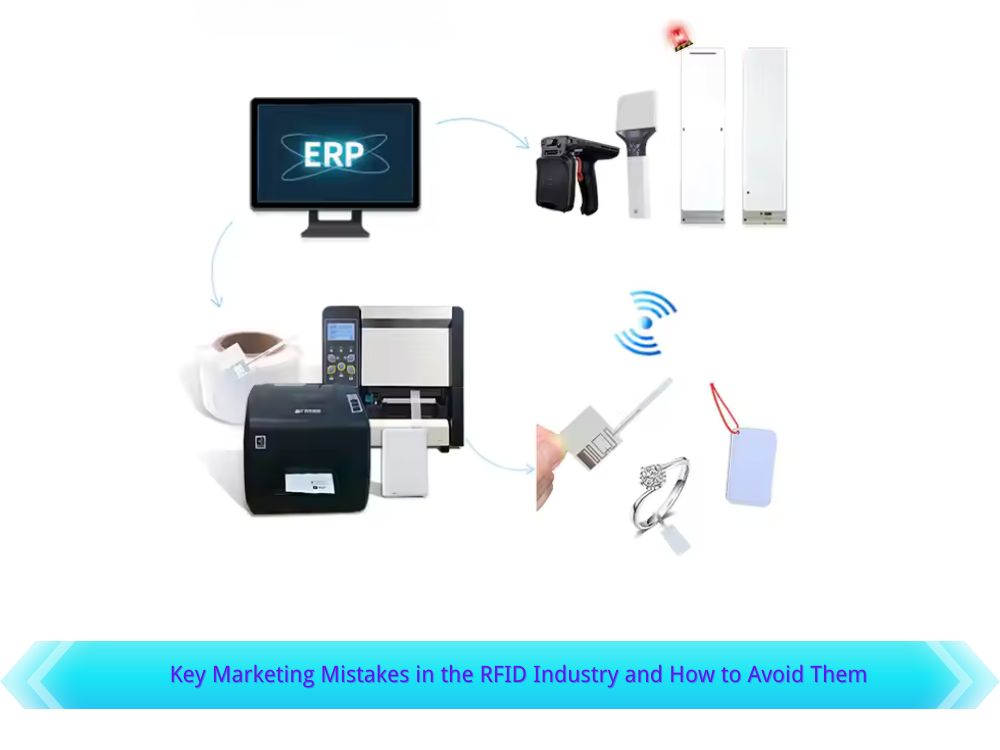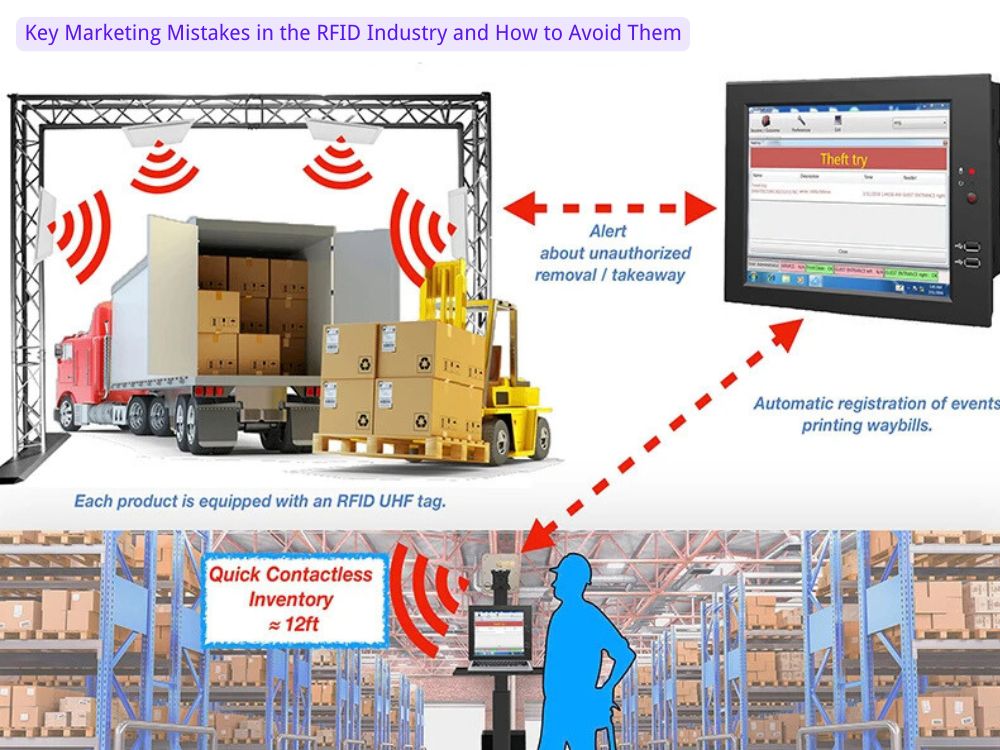
Key Marketing Mistakes in the RFID Industry and How to Avoid Them
Table of Contents
Summary
However, despite these advancements, many RFID companies continue to make critical marketing mistakes that hinder their success. By understanding and addressing these common errors, RFID firms can better position themselves in the market, attract the right customers, and drive business growth.

Common Marketing Pitfalls
Selling Parts Instead of Complete Solutions
One of the most frequent mistakes made by RFID companies is focusing on selling individual components—such as tags, readers, or software—rather than offering comprehensive solutions to specific business problems. While it’s essential to excel in individual areas, providing a complete, integrated solution can better address complex challenges such as asset management, inventory tracking, and work-in-process monitoring.
Advantages of Offering Complete RFID Solutions
Benefit | Description |
Holistic Approach | Addresses all aspects of RFID deployment, from tagging to data analysis |
Increased Customer Satisfaction | Provides a one-stop solution, reducing the need for multiple vendors |
Enhanced Market Position | Differentiates the company from competitors offering only components |
Making Products Too Complicated
Complexity in RFID products can be a significant barrier to adoption. A common issue is the failure to provide user-friendly setup instructions and demonstrations. For instance, RFID readers or tags should be designed for straightforward use, with clear instructions and simple demonstration applications that allow potential clients to test the technology easily.
Example of Complicated Product Issues
A manufacturer’s RFID reader, intended for use with Android smartphones, exemplifies this problem. Despite its innovative design, users struggled with setup due to inadequate instructions. This complexity not only frustrated users but also delayed potential adoption and sales.
Targeting the Right Market
Marketing to the Wrong Audience
Many RFID companies waste resources by marketing to audiences that are not actively seeking RFID solutions. Effective marketing requires targeting industries and companies that are already considering or actively researching RFID technology. Misaligned marketing efforts can lead to wasted time and budget without achieving meaningful results.
Understanding Industry Needs
Industries with high RFID adoption rates include retail, healthcare, and logistics. Targeting these sectors, where RFID has demonstrated clear benefits, is more likely to yield positive outcomes compared to less receptive industries.
RFID Adoption by Industry
Industry | Adoption Rate | Typical Applications |
Retail | High | Inventory management, asset tracking |
Healthcare | Moderate | Patient tracking, asset management |
Logistics | High | Supply chain management, tracking |
Construction | Low | Limited adoption due to fragmentation |
Budgeting for Marketing
Not Allocating Budget for Marketing
A crucial mistake is underfunding marketing efforts. Geoffrey Moore’s principle in Escape Velocity suggests that a technology company should allocate as much budget for marketing as it does for product development. However, many RFID companies neglect this, focusing solely on development and leaving insufficient funds for branding and market penetration.
Impact of Inadequate Marketing Budget
Without proper marketing investment, RFID companies struggle to build brand recognition and reach potential clients. This shortfall often results in missed opportunities at industry events and a lack of visibility in a competitive market.
Strategies for Effective Marketing
Effective Marketing Strategies
To overcome these challenges, RFID companies should adopt several strategies:
- Offer Integrated Solutions: Develop and promote comprehensive RFID solutions that address specific industry problems.
- Simplify Product Usability: Ensure products are easy to set up and use, with clear instructions and demo applications.
- Target Relevant Markets: Focus marketing efforts on industries with high RFID adoption rates and those actively seeking RFID solutions.
Allocate Adequate Budget: Invest sufficiently in marketing to build brand recognition and reach potential customers effectively.

Conclusion
The pilot phase is a crucial step in the successful deployment of RFID systems. By following a structured approach, companies can identify the most effective use cases, improve inventory management, and lay the groundwork for a full-scale rollout. With careful planning and execution, RFID pilots can lead to significant operational improvements and a strong return on investment.
Comments
Hot Products

What Is RFID Waste Management
Imagine a city where every trash bin speaks — not literally — but through a tiny chip that tells the system when it’s full, when it’s emptied, and where it went. That’s what RFID waste management is doing today.

What are Bolt Seals and their Applications? | Complete Guide
In global trade and logistics, bolt seals play a crucial role in ensuring cargo security and compliance. These small but powerful devices are designed to lock shipping containers, trailers, and cargo doors with a tamper-evident mechanism.

What is an RFID Card Protector? Benefits, Use Cases, and Buying Guide
RFID technology (Radio Frequency Identification) is everywhere: in your credit cards, ID badges, transit passes, hotel room keys, and more. It offers speed and convenience, but it also opens the door to a new kind of digital theft called “skimming.” That’s where an RFID card protector comes in.

RFID Wristbands for Events: Bulk Buying Guide for Organizers
RFID wristbands for events are becoming the go-to solution for organizers who need faster entry, fraud prevention, and cashless payments at concerts, festivals, and sports venues. Unlike paper tickets or QR codes, these smart wristbands use embedded chips to streamline access, secure transactions, and improve the guest experience.

How RFID Tag on Windscreen Improves Vehicle Access Control and Toll Systems
In today’s fast-paced world, vehicle identification needs to be quick, secure, and contactless. An RFID Tag on the Windscreen provides exactly that — a reliable way to manage toll collection, parking, and gated access without stopping vehicles.

The Benefits of RFID Linen Tags in Commercial Laundry
Managing laundry in hospitals, hotels, or large laundry services is a big job. Each day, thousands of sheets, towels, and uniforms are washed, sorted, and sent back out. But problems like lost linens, sorting mistakes, and manual counting can cost companies a lot of money. For example, mid-sized hotels can lose over $200,000 each year from missing linens.
That’s where RFID Linen Tags come in.
Tags
RELATED BLOGS

What Is RFID Waste Management
Imagine a city where every trash bin speaks — not literally — but through a tiny chip that tells the system when it’s full, when it’s emptied, and where it went. That’s what RFID waste management is doing today.

What are Bolt Seals and their Applications? | Complete Guide
In global trade and logistics, bolt seals play a crucial role in ensuring cargo security and compliance. These small but powerful devices are designed to lock shipping containers, trailers, and cargo doors with a tamper-evident mechanism.

What is an RFID Card Protector? Benefits, Use Cases, and Buying Guide
RFID technology (Radio Frequency Identification) is everywhere: in your credit cards, ID badges, transit passes, hotel room keys, and more. It offers speed and convenience, but it also opens the door to a new kind of digital theft called “skimming.” That’s where an RFID card protector comes in.




